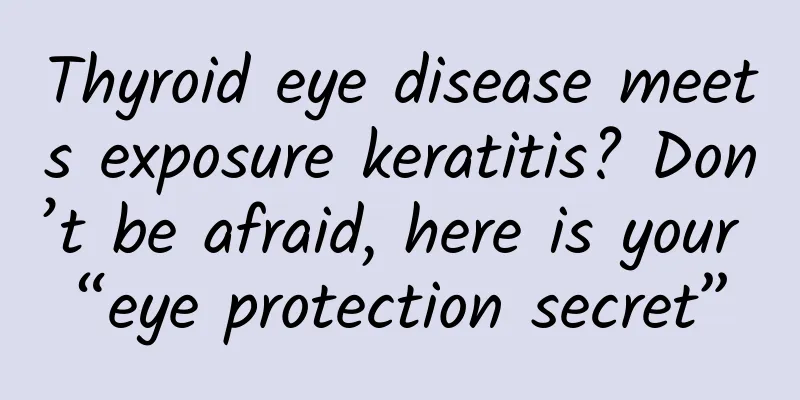Thyroid eye disease meets exposure keratitis? Don’t be afraid, here is your “eye protection secret”

|
Authors: Jing Mengmin, Gao Liandi, Yin Xiaolin Thyroid eye disease, also known as thyroid-associated ophthalmopathy (TAO), is an autoimmune eye disease caused by thyroid disease, while exposure keratitis is a disease that causes corneal damage due to incomplete eyelid closure. In this fast-paced era, thyroid problems are increasingly becoming a health issue that we cannot ignore. While you are worried about thyroid eye disease, a more hidden enemy, exposure keratitis, may be approaching quietly. Uncovering the invisible threat: The truth about exposure keratitis The cornea is the outermost layer of the eyeball. It has no blood vessels and mainly obtains nutrition through tears and aqueous humor. Blinking can distribute tears evenly on the surface of the eye and keep the cornea moist. Exposure keratitis refers to corneal inflammation caused by the cornea losing the protection of the eyelids and being exposed to the air, which causes dryness, epithelial shedding, ulcers, etc., and then secondary infection. It often occurs below the cornea. Its symptoms include corneal surface exposure, dryness, blurriness, necrosis, shedding, ulcers or corneal epithelial keratin degeneration. This is not just eye discomfort, it may seriously damage vision. If not treated in time, it may lead to corneal ulcers or even perforations, iris prolapse, visual impairment or even blindness, threatening your daily life.
When these two diseases occur at the same time, eye health will face severe challenges. Once you find symptoms such as dry eyes, pain, blurred vision, etc., you should seek medical attention immediately without delay. As an ophthalmologist, we are well aware of your concerns about such problems, so we have prepared a "eye protection secret" for you to help you deal with it scientifically and protect your eyes. Self-help guide: daily care and preventive measures 1. Avoid prolonged exposure: Try to minimize the time your eyes are exposed to the air. This will help reduce the evaporation of tears and relieve dry eyes. (1) Wear protective glasses: Avoid going out when the light is strong. If you need to go out, please wear dark, wide sunglasses to reduce the irritation of light and dust to the eyes, or wear corneal contact lenses or soft bandage lenses, or wear wet chamber lenses. At the same time, you can use a sun hat, sun umbrella, etc. to assist in sun protection. Avoid direct sunlight to the eyes, and prevent foreign objects such as sand from entering the eyes, which will aggravate the condition. (2) Nighttime protection: For patients with incomplete eyelid closure, they should apply eye ointment before going to bed as prescribed by the doctor, and wear a breathable and lightweight eye mask if necessary to prevent foreign objects from falling into the eyes. Close the eyes voluntarily and use medical tape to seal the upper and lower eyelids before going to bed. 2. Medication to keep eyes moist: Preventive medication: You can use preservative-free artificial tears for a long time during the day, and apply antibiotic eye ointment to cover the cornea before going to bed. Treatment medications: antibiotic eye drops to prevent infection, corneal repair eye gel, autologous serum, etc. (1) Sodium hyaluronate eye drops: can be used to treat exposure keratitis. It has the effect of moisturizing the conjunctiva and cornea and promoting corneal epithelial repair. It can be applied 4-6 times a day. (2) Antibiotic eye ointment: Apply to eyes before going to bed to prevent infection and keep eyes moist. It is contraindicated for those who are allergic to this antibiotic. (3) If there is a defect in the corneal epithelium, you can use eye drops that promote corneal epithelial repair, such as calf blood protein-free eye gel, and apply it to the eyes three times a day. It is worth noting that this type of eye drops usually need to be refrigerated and can only be used for 7 days after opening. Please note that the above drugs are for reference only and do not constitute professional medication recommendations. When choosing eye drops, patients with exposure keratitis should consult a professional doctor or ophthalmologist to choose the appropriate drug according to the specific condition and doctor's advice. At the same time, patients also need to pay attention to eye hygiene and avoid long-term use of the eyes, which will cause visual fatigue and aggravate the condition. 3. Adjust your lifestyle (1) Adequate sleep: Maintain good living habits, ensure adequate sleep time, avoid staying up late, use a high pillow when sleeping, and keep the head higher than the body. This can help reduce the swelling of the eyelids in the morning and relieve eye fatigue.
(4) Maintain a happy body and mind: Thyroid disease is a "physical and mental disease" that is closely related to emotions. Therefore, to overcome thyroid disease, you must effectively prevent it and maintain a positive and optimistic attitude. At the same time, you must actively exercise to improve your immunity and resistance. Do a moderate amount of aerobic exercise, such as walking, jogging, etc., to improve immunity and strengthen your physical fitness. (5) Keep your eyes clean: Pay attention to eye hygiene and do not rub your eyes with your hands to prevent bacteria from entering the eyes and worsening the condition. You can use mild eye cleansing products to keep your eyes clean. (6) Reasonable eye habits Avoid prolonged eye use: Do not use computers or mobile phones or other electronic products for a long time, and take a break in between. Usually, you should take a 5-10 minute break after one hour of continuous operation. You can look into the distance or do eye exercises during the break. Maintain a proper posture: When using electronic products, maintain a proper posture with your eyes looking level or slightly downward at the screen. This can relax the neck muscles and reduce the area of the eyeballs exposed to the air. Adjust the screen distance and angle: It is recommended that the screen be 50-70 cm away from the eyes, and the screen should be slightly below the eye level by 10-20 cm, with a downward viewing angle of 15-20 degrees. This can reduce the need for refraction and reduce the chance of eye fatigue. 4. Actively accept professional treatment: Control thyroid disease: Thyroid eye disease is one of the complications of thyroid disease. Therefore, actively treating thyroid disease is the key to preventing and controlling thyroid eye disease. Please take medicine on time as prescribed by your doctor and have your thyroid function checked regularly. Comprehensive treatment of exposure keratitis: For the treatment of exposure keratitis, the appropriate treatment should be selected according to the severity of the disease. In the early stage, artificial tears and corneal protective solution can be used to relieve symptoms; when the disease is serious, surgical treatment can be considered, such as amniotic membrane transplantation, eyelid suturing, etc. Regular check-ups: Go to the hospital for regular check-ups of thyroid function to keep abreast of changes in your condition. If you experience corneal opacity, decreased vision, increased eye secretions, or other abnormalities, please seek medical attention immediately. Social attention: Let love spread and build a healthy defense line together With the increasing incidence of thyroid diseases, thyroid eye disease complicated with exposure keratitis has gradually entered the public eye. Facing this dual challenge, experts remind us: early identification and timely intervention are crucial! Once you find symptoms such as dry eyes, pain, blurred vision, etc., you should seek medical attention immediately without delay. Although there are many challenges, as long as we are vigilant and respond scientifically, we can effectively protect our bright vision. Let us work together to add points to our health and add color to our lives! The above pictures are from the Internet Planning and production author| Editor | Yin Xiaolin, Head Nurse of Ophthalmology Department, Second Affiliated Hospital of Naval Medical University Producer | Gao Liandi, Chief Nurse and Head Nurse of the Nursing Department of the Second Affiliated Hospital of Naval Medical University Produced by: Department of Ophthalmology, The Second Affiliated Hospital of the Naval Medical University of the Chinese People's Liberation Army |
<<: Health Science | Why does your body itch when the weather gets colder?
>>: Sweet potatoes are a good remedy for cardiovascular disease
Recommend
When is the best time to monitor follicles?
The follicles are the guarantee of women's im...
Can Pueraria lobata breast enhancement soup enlarge breasts?
The size of the breasts is a standard for judging...
What is the secret to quick breast enlargement?
For the majority of female friends, breast enhanc...
Is it normal to not have breast pain during early pregnancy?
Compared with the entire pregnancy period, the ea...
Is the stabbing pain in the lower abdomen like a needle prick a sign of implantation?
With the opening of the second-child policy, many...
The reason why you feel depressed in autumn and winter has been found! Do these things to stay away from seasonal depression!
The temperature has dropped suddenly in the past ...
How to pay attention to white discharge in female urethra
As we all know, the female body structure is very...
Can flowers be planted in hardened soil? How to deal with hard soil in flower pots?
As people's quality of life improves, more an...
What is the pain next to the breast?
Today we are going to introduce one of the common...
Can I eat lotus seeds after abortion?
When women have an unexpected pregnancy, they oft...
How many days does it take to delay your period by taking emergency contraceptive pills?
It is normal for menstruation to be delayed due t...
Increased accessory breast size during pregnancy
Pregnant women may often feel some discomfort in ...
Will the fetus blame the mother if the abortion is induced?
Induced abortion means sentencing the fetus to de...
What causes breast pain in women
Most women will experience symptoms of breast pai...
Pictures of normal menstrual color
We think it is normal for menstrual blood to be d...









